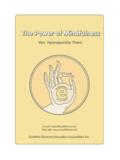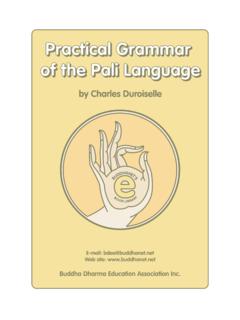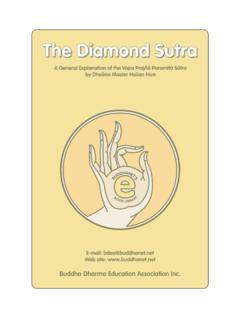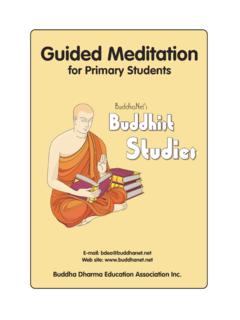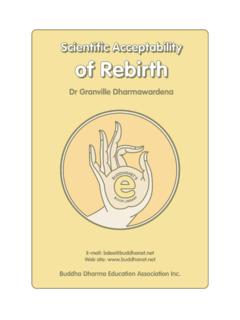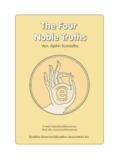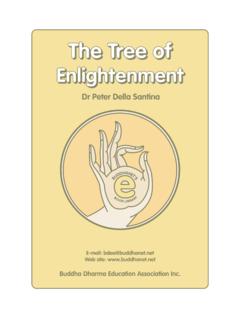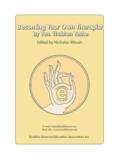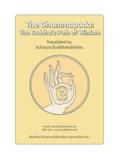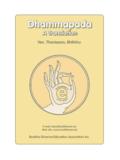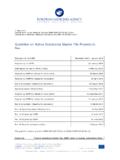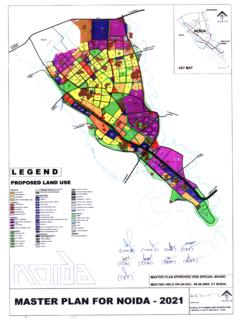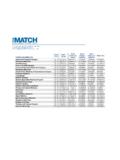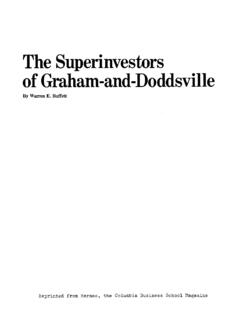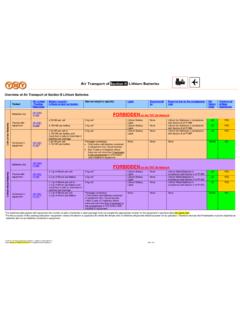Transcription of Taming the Monkey Mind - Buddhism
1 EBUDDHANET'SBOOKLIBRARYE-mail: site: Dharma Education Association Guide to Pure Land Practiceby the Buddhist Scholar Cheng Wei-anTranslation with Commentary byDharma master SuddhisukhaTaming the Monkey MindTaming the Monkey mind 2 Taming The Monkey mind A Guide to Pure Land Practice by the Buddhist scholar Cheng Wei-an Translation with Commentary by Dharma master Suddhisukha Sutra Translation Committee of the U. S. and Canada New York San Francisco Niagara Falls Toronto May 2000 3 The Chinese original of this translation, Nien-fo ssu-shih-pa fa by the Buddhist scholar Cheng Wei-an, is reprinted (together with Elder master Yin Kuang s work Ching-yeh Chin- liang) in: Ch en Hsi-yuan, ed.
2 , Ching-t u Ch ieh-yao [Essentials of Pure Land], Taiwan, 1968. Cheng Wei-an s text has been translated into Vietnamese twice, under the title 48 Phap Niem Phat by Trinh Vi-Am. The better known version was published in 1963 with a commentary by Dharma master Thich Tinh Lac (Skt: Suddhisukha). 4 Contents List of Contents Note to the Eng lish Edition x5 Acknowledgements x6 Pur e Land in a Nutshell x7 Preface 10 Text: 48 Aspects of Buddha Recit ati on 12 Appendices: The Bodhi mind x75 Introducti on to Pure Land Buddhism 113 Notes 135 Index 147 Dedication of Merit 150 5 Note to the English Edition The present treatise, a Pure Land classic, is part of a multilingual series on Pure Land Buddhism published by the Sutra Translation Committee of the United States and Canada.
3 It deals specifically with the main practice of the Pure Land School Buddha Recitation and covers both the noumenal and phenomenal aspects of that practice. The treatise is accompanied by the de-tailed commentary of an Elder master of the Zen and Pure Land lineages. Readers not familiar with Pure Land theory may wish to begin with Dr. J. C. Cleary s introducti on. ** Of all the forms of Buddhism practiced in East Asia, Pure Land has been the most widespread for over a millennium.
4 It can be found throughout the Mahayana canon, with specific references in more than 200 texts (Encyclopedia of Buddhism ). In one such text, the Avatamsaka Sutra, the story is told of a wordless sutra, equal in extent to the universe, existing in each and every atom. What is this sutra? It is the Sutra of the mind the embodiment of the tenet that everything is made from mind alone. And so we come to a key teaching which underlies the entire Buddhist canon, in which Pure Land figures so prominently: to attain the mind of Enlightenment, to 6become a Buddha, the first step is development of the Bodhi mind the aspiration to achieve Buddhahood for the benefit of all sentient beings.
5 It is with this parting thought that we leave the reader, as we wish him a pleasant excursion into Buddha Recitation, a profound yet democratic form of Buddhist practice. Minh Thanh & P. D. Leigh, Editors (English edition) Rye Brook, New York: Festival of Amitabha, 12/99 Suddhisukha Temple of Zen Summer Retreat, 1963 Acknowledgements We respectfully and gratefully acknowledge the support and counsel of Dharma master Lok To, master Thich Phuoc Bon and Rev. K. Watanabe, along with the helpful comments and suggestions of Upasaka Hien Mat (who gladly reviewed this entire book in less than a ksana!)
6 , Upasaka Minh Con and Upasaka Sean Everett. Special mention is due to Upasaka Thieu Chuu, who through his own vernacular translation of this commen-tary more than half a century ago, clarified many diffi-cult passages and transcendental points of Dharma. Without their invaluable contributions, this book would not have been possible. 7 Pure Land in a Nutshell Of the various forms of Buddhism that developed after the demise of the historical Buddha in 480 B. C., Maha-yana (the Great Vehicle ) became the dominant tradit-ion in East and parts of Southeast Asia.
7 This broad area encompasses China, Korea, Vietnam and Japan, among other countries. In time, a number of schools arose within Mahayana Buddhism in accordance with the capacities and circum-stances of the people, the main ones being the Zen, Pure Land and Esoteric schools. Among these schools, Pure Land has the greatest number of adherents, although its teachings and methodology are not widely known in the West. Given its popular appeal, [Pure Land] quickly became the object of the most dominant form of Buddhist devotion in East Asia.
8 (M. Eliade, ed., Encyclopedia of Religions, Vol. 12.) What is Pure Land? [Pure Land comprises the schools] of East Asia which emphasize aspects of Mahayana Budd-hism stressing faith in Amida, meditation on and recitation of his name, and the religious goal of being reborn in his Pure Land, or 8 Western Paradise. (Keith Crim, editor, Peren-nial Dictionary of World Religions, p. 586.) The most common Pure Land practice is the recitation of Amitabha Buddha s name (Buddha Recitation or Buddha Remembrance). This should be done with utmost faith and a sincere vow to achieve rebirth in the Pure Land.
9 Along with this popular form of Pure Land, there is a higher aspect, in which Amitabha, the Buddha of Infinite Light and Life, is equated with our Buddha Nature, infinitely brigh t and everlasting (Self-Nature Amitabha, mind -Only Pure Land ). Thus, to recite the Buddha s name is to recit e the Buddha of our own mind , to return to our own pure mind . Main Characteristics of Pure Land i) Its teachings are based on compassion, on faith in the compassionate Vows of Amitabha Buddha to welcome and guide all sentient beings to His Pure Land.
10 Ii) It is an easy method, in terms of both goal (rebirth in the Western Pure Land as a stepping-stone toward Buddhahood) and form of cultivation (can be practiced anywhere, any time with no special liturgy, accoutre-ments or guidance). 9iii) It is a panacea for the diseases of the mind , unlike other methods or meditations which are directed to specific illnesses (e. g., meditation on the corpse is de-signed to sever lust, counting the breath is meant to rein in the wandering mind ). iv) It is a democratic method that empowers its adherents, freeing them from arcane metaphysics as well as dependence on teachers and other mediating authority figures.
